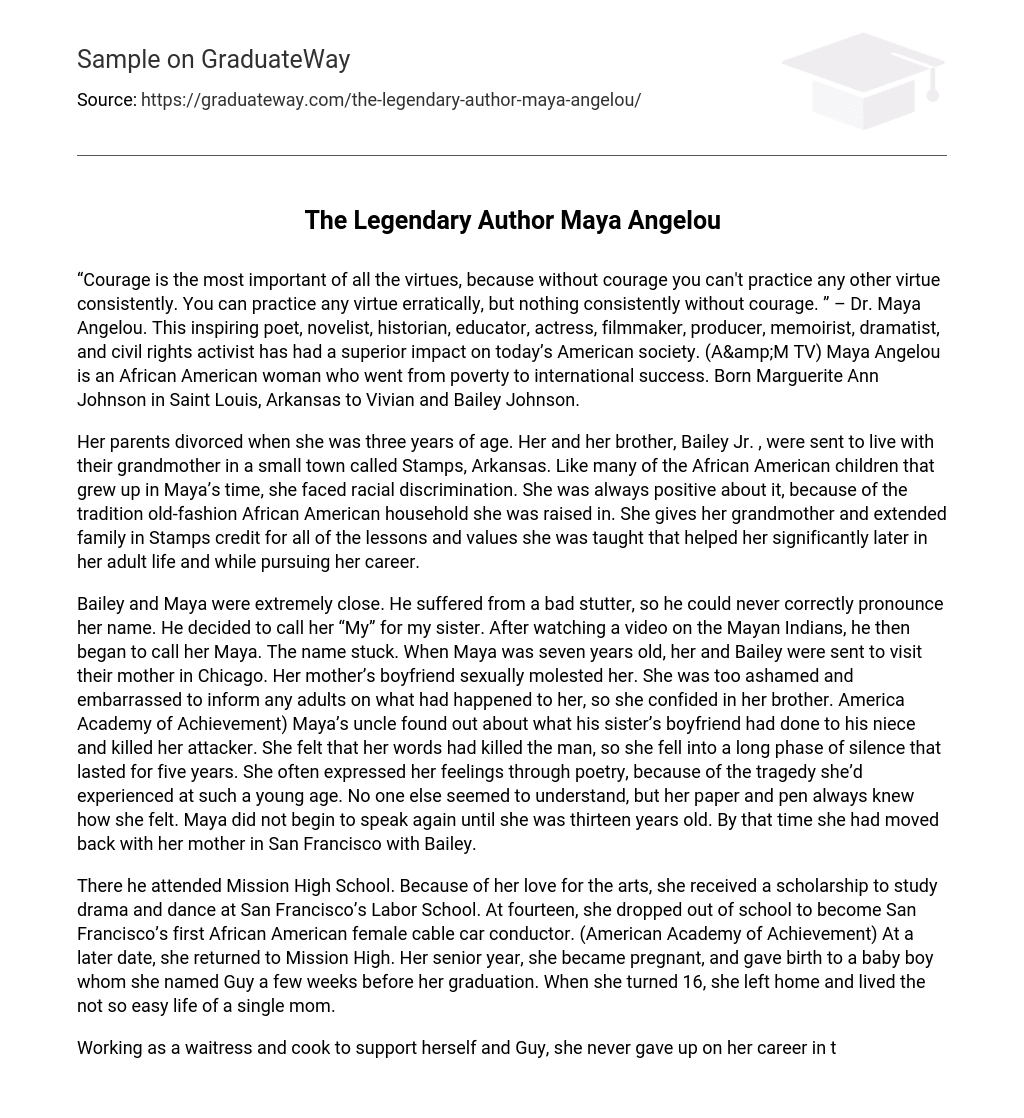“Courage is the most important of all the virtues, because without courage you can’t practice any other virtue consistently. You can practice any virtue erratically, but nothing consistently without courage. ” – Dr. Maya Angelou. This inspiring poet, novelist, historian, educator, actress, filmmaker, producer, memoirist, dramatist, and civil rights activist has had a superior impact on today’s American society. (A&M TV) Maya Angelou is an African American woman who went from poverty to international success. Born Marguerite Ann Johnson in Saint Louis, Arkansas to Vivian and Bailey Johnson.
Her parents divorced when she was three years of age. Her and her brother, Bailey Jr. , were sent to live with their grandmother in a small town called Stamps, Arkansas. Like many of the African American children that grew up in Maya’s time, she faced racial discrimination. She was always positive about it, because of the tradition old-fashion African American household she was raised in. She gives her grandmother and extended family in Stamps credit for all of the lessons and values she was taught that helped her significantly later in her adult life and while pursuing her career.
Bailey and Maya were extremely close. He suffered from a bad stutter, so he could never correctly pronounce her name. He decided to call her “My” for my sister. After watching a video on the Mayan Indians, he then began to call her Maya. The name stuck. When Maya was seven years old, her and Bailey were sent to visit their mother in Chicago. Her mother’s boyfriend sexually molested her. She was too ashamed and embarrassed to inform any adults on what had happened to her, so she confided in her brother. America Academy of Achievement) Maya’s uncle found out about what his sister’s boyfriend had done to his niece and killed her attacker. She felt that her words had killed the man, so she fell into a long phase of silence that lasted for five years. She often expressed her feelings through poetry, because of the tragedy she’d experienced at such a young age. No one else seemed to understand, but her paper and pen always knew how she felt. Maya did not begin to speak again until she was thirteen years old. By that time she had moved back with her mother in San Francisco with Bailey.
There he attended Mission High School. Because of her love for the arts, she received a scholarship to study drama and dance at San Francisco’s Labor School. At fourteen, she dropped out of school to become San Francisco’s first African American female cable car conductor. (American Academy of Achievement) At a later date, she returned to Mission High. Her senior year, she became pregnant, and gave birth to a baby boy whom she named Guy a few weeks before her graduation. When she turned 16, she left home and lived the not so easy life of a single mom.
Working as a waitress and cook to support herself and Guy, she never gave up on her career in the arts. Maya married her husband, Anastasois Angelopulos, in 1952. When she began to dance at a nightclub for a living, she took combined her childhood nickname with a part of her husband’s last name as a stage name. Although her marriage did not last, her career never came to a halt. It was a new beginning for her. She went on tour in Europe with a production of the Porgy and Bess produced by George Gershwin. After that, she toured 22 countries in both Europe and Africa. Encyclopedia Britannica) During the same time, she studied dance with Martha Graham and Pearl Primus. In the late 1950s she settled down in New York and became a member of the Harlem Writer’s Guide. As a part of their group, more and more of her poetry was published to the eyes of American reviewers. In 1961, she performed in Jean Genet’s The Blacks and moved to Cairo, Egypt to work for the Arab Observer. Later, she moved to Ghana as an employer of the African Review. In 1966, she returned to America, where she wrote her first 10-part television series about the role of African culture in American life, called Black, Blues, Black.





